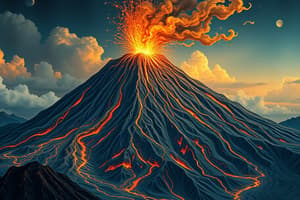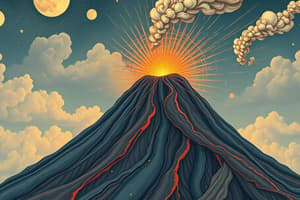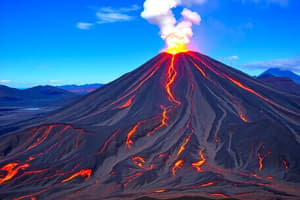Podcast
Questions and Answers
Explain the difference between a shield volcano and a stratovolcano, highlighting their distinctive shapes and eruptive styles.
Explain the difference between a shield volcano and a stratovolcano, highlighting their distinctive shapes and eruptive styles.
Shield volcanoes are broad, gently sloping mountains formed by effusive eruptions of basaltic lava, producing fluid, low-viscosity flows that spread widely. In contrast, stratovolcanoes are tall, cone-shaped mountains created by explosive eruptions of viscous, gas-rich magma, generating layers of ash and lava.
Describe two distinct types of volcanic eruptions, outlining their characteristics, associated hazards, and potential landforms.
Describe two distinct types of volcanic eruptions, outlining their characteristics, associated hazards, and potential landforms.
Two examples are Plinian eruptions, characterized by highly explosive, gas-driven eruptions spewing ash columns and pyroclastic flows, posing risks of widespread ashfall and devastating surges. Another type is Hawaiian eruptions, which involve effusive, non-explosive flows of very fluid lava, creating extensive lava fields and shield volcanoes. These eruptions are less destructive but can cause significant damage to infrastructure and ecosystems.
Discuss how volcanic eruptions can benefit society, highlighting specific examples of positive impacts.
Discuss how volcanic eruptions can benefit society, highlighting specific examples of positive impacts.
While eruptions pose risks, they also have benefits. Volcanic ash enriches soil fertility, aiding agriculture. Geothermal energy harnessed from volcanic heat provides clean energy sources. Volcanic landscapes attract tourism, boosting local economies. Furthermore, volcanic rock formations can be valuable natural resources for construction and industry.
Explain the importance of monitoring volcanic activity and the types of signs that indicate an impending eruption.
Explain the importance of monitoring volcanic activity and the types of signs that indicate an impending eruption.
Describe three ways in which volcanic eruptions can significantly impact human societies, including both immediate and long-term consequences.
Describe three ways in which volcanic eruptions can significantly impact human societies, including both immediate and long-term consequences.
Flashcards
Classification of volcanoes
Classification of volcanoes
Volcanoes are classified into three main types: active, dormant, and extinct.
Volcanic landforms
Volcanic landforms
Landforms created by volcanic activity include mountains, islands, and craters.
Eruptive styles
Eruptive styles
Different eruptive styles include effusive eruptions and explosive eruptions.
Effects on society
Effects on society
Signup and view all the flashcards
Signs of eruption
Signs of eruption
Signup and view all the flashcards
Study Notes
Volcano Classification
- Volcanoes are classified based on their eruptive style and the shape of the cone they form.
- Shield volcanoes are broad, gently sloping volcanoes formed by fluid lava flows.
- Cinder cone volcanoes are small, steep-sided volcanoes built from ejected fragments of lava.
- Composite volcanoes, also known as stratovolcanoes, are large, cone-shaped volcanoes composed of alternating layers of lava and ash.
- Caldera volcanoes are formed by the collapse of a magma chamber following a massive eruption.
Volcanic Landforms and Eruptive Styles
- Volcanic landforms include lava flows, pyroclastic flows, volcanic ash, cinder cones, and calderas.
- Eruptive styles vary significantly, ranging from effusive eruptions (characterized by fluid lava flows) to explosive eruptions (characterized by frequent bursts of ash and gas).
Types of Volcanic Eruptions
- Volcanic eruptions are categorized based on the explosiveness and the type of material they release.
- Hawaiian eruptions are characterized by relatively quiet lava flows.
- Strombolian eruptions are characterized by intermittent explosions of lava fragments.
- Vulcanian eruptions are characterized by violent explosions, throwing out fragments of lava and gas.
- Plinian eruptions are the most powerful, producing huge columns of ash and gas that reach the stratosphere.
Energy from Volcanoes
- Volcanoes can release geothermal energy.
- The heat from magma can be harnessed to generate electricity.
- Geothermal energy is a renewable source of energy.
Volcanic Eruptions and Society
- Volcanic eruptions often have significant impacts on human populations and environments.
- Eruptions can result in significant economic losses.
- Damage to infrastructure (roads, buildings, bridges, etc.) is common.
- Volcanic ash can affect air travel and disrupt normal life.
- Loss of life may result form the eruption.
Signs of Impending Volcanic Eruptions
- Several signs can indicate an impending volcanic eruption.
- These include increased seismic activity (earthquakes), changes in gas emissions, ground deformation, and changes in heat flow.
- Monitoring of these signs is crucial to assess volcanic risk and issue timely warnings.
Studying That Suits You
Use AI to generate personalized quizzes and flashcards to suit your learning preferences.




